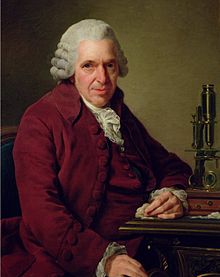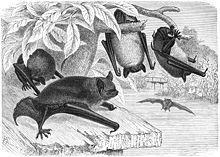Louis Jean-Marie Daubenton

Louis Jean-Marie Daubenton , actually d'Aubenton , (born May 29, 1716 in Montbard , Burgundy , † December 31, 1799 in Paris ) was a French doctor and naturalist .
Life
Daubenton first studied at the University of Dijon . His father Jean Daubenton (1669–1736), a notary and also an encyclopedist , had appointed him priest and sent him to Paris to study theology there. His mother was Marie Pichenot (* approx. 1680), his brother was the lawyer and politician Pierre Daubenton , who was also active as an author in the Encyclopédie by Denis Diderot and Jean-Baptiste le Rond d'Alembert .
Daubenton secretly studied medicine and anatomy in Paris . It was not until his father's death in 1736 that he then allowed him to pursue his desired professional qualifications. In 1739 he went to Reims , where he became a doctor of medicine ( Docteur en médecine ) in 1741 and returned to his native Paris to practice there.
Around 1742, Georges-Louis Buffon , who also came from Montbard, began to realize his plan to write a great treatise on natural history or the general and special history of nature, Histoire naturelle générale et particulière . Right from the start he invited Daubenton to help him with the anatomical descriptions for this work. In 1745 he became a guard and declarer ( garde-demonstrateur ) at the natural history cabinet ( Cabinet du roi ), later the Muséum national d'histoire naturelle , in Paris.
For the section on the natural history of animals in the Encyclopédie méthodique (1782-1832) - it is a revision, extension and redistribution of the Encyclopédie ou Dictionnaire raisonné des sciences, des arts et des métiers by Denis Diderot and d'Alembert - Daubenton wrote the three dictionaries of the quadrupeds and whales (1782) and on the egg-laying quadrupeds and snakes (1784), and the fish (1787).
A protégé of Daubenton became Vicq d'Azyr , who had been studying medicine in Paris since 1765 . Around 1770 he attended events in the Jardin du Roi . Vicq d'Azyr's married a niece of Daubentons in 1773, but she died eighteen months later.
In 1783 Daubenton became a teacher of economics at the veterinary school École nationale vétérinaire d'Alfort at Alfort Castle near Paris, in 1795 professor of natural history at the École normal supérieure in Paris and director of the natural history cabinet.
In December 1799 he became a member of the Senate ( Sénat conservateur ) (see also History of the French Senate ). While attending the first meeting he attended, he fell from his seat. He suffered a stroke , of the consequences of which he died on December 31, 1799 in Paris after a short course of illness. In 1799, Daubenton's serious illness also made the chair of the natural history department at the Collège de France vacant, and it was Georges Cuvier who was appointed to this responsible post.
Since 1752 he was a foreign member of the Prussian Academy of Sciences and from December 1776 honorary member of the Russian Academy of Sciences in Saint Petersburg . In 1755 he was elected a member ( Fellow ) of the Royal Society and in 1775 a member of the American Philosophical Society .
plant
Daubenton made anatomical contributions to the first five volumes of Buffon's natural history. His research on the improvement of wool production in sheep , published in his “ Instruction pour les bergers ” (1782), saved him from the persecution of the French Revolution by presenting himself as remote from politics and thus obtaining a safety certificate from the National Convention .
Taxa named after Daubenton
The scientific name of the water bat ( Myotis daubentonii ) and the finger animal ( Daubentonia madagascariensis ) goes back to Louis Jean-Marie Daubenton.
Works (selection)
- Instruction for the bergers et for the property owners de troupeaux . (1782)
literature
- Jacques Roger: Buffon. Cornell University Press, Cornell History of Science Series, 1997, ISBN 0-8014-2918-8 , p. 20
Web links
- Literature by and about Louis Jean-Marie Daubenton in the catalog of the German National Library
- Works by and about Louis Jean-Marie Daubenton in the German Digital Library
Individual evidence
- ↑ The date of death follows the information on the tombstone; in contrast to this, January 1, 1800 is mentioned as the date of death in the literature.
- ↑ Family genealogy
- ↑ Paul Lawrence Farbee: Buffon and Daubenton: Divergent Traditions within the Histoire Naturelle Department of General Science, Oregon State University, Corvallis, Oregon (1973) pp. 63-74, online
- ^ André Parent: Félix Vicq d'Azyr: Anatomy, Medicine and Revolution. Can. J. Neurol. Sci. 2007; 34: 30-37, online (PDF; 401.58 kB)
- ↑ Biographical data
- ↑ Encyclopedia 1902_Baron Cuvier
- ^ Members of the previous academies. Louis-Jean-Marie Daubenton (d'Aubenton). Berlin-Brandenburg Academy of Sciences , accessed on February 17, 2015 .
- ^ Foreign members of the Russian Academy of Sciences since 1724. Louis-Jean-Marie Daubenton. Russian Academy of Sciences, accessed August 27, 2015 .
- ^ Member History: Louis JM Daubenton. American Philosophical Society, accessed July 6, 2018 .
| personal data | |
|---|---|
| SURNAME | Daubenton, Louis Jean-Marie |
| ALTERNATIVE NAMES | Aubenton, Louis Jean-Marie d ' |
| BRIEF DESCRIPTION | French doctor and naturalist |
| DATE OF BIRTH | May 29, 1716 |
| PLACE OF BIRTH | Mountable |
| DATE OF DEATH | December 31, 1799 |
| Place of death | Paris |


